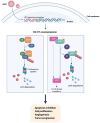HPV and Lung Cancer: A Systematic Review
- PMID: 39409943
- PMCID: PMC11475761
- DOI: 10.3390/cancers16193325
HPV and Lung Cancer: A Systematic Review
Abstract
This systematic review aims to explore the diagnostic criteria, epidemiology, etiology, and prognosis of Human Papillomavirus (HPV) infection in lung cancer. This PRISMA-guided review searched the PubMed® and EmbaseTM databases for "lung cancer AND HPV" on 10 June 2023, filtering human subject papers. A total of 97 studies encompassing 9098 patients worldwide, revealing varied HPV infection rates in lung cancer, ranging from 0% to 69%, were analyzed. While HPV16/18 was predominant in some regions, its association with lung cancer remained inconclusive due to conflicting findings. Studies from Asia reported lower HPV infection rates compared to Western populations. Some studies suggested a limited role of HPV in lung carcinogenesis, particularly in non-smokers. However, intriguing associations were noted, including HPV's potential role in lung adenocarcinoma and squamous cell carcinoma. Discrepancies in HPV detection methods and sample sources highlight the need for further research with standardized methodologies to elucidate HPV's role in lung carcinogenesis and its clinical implications. Overall, this systematic review offers insights into HPV's role in lung cancer epidemiology and clinical characteristics. Despite inconclusive evidence, intriguing associations between HPV and lung adenocarcinoma and squamous cell carcinoma have emerged. Further research with standardized methodologies and larger cohorts is needed for clarity.
Keywords: HPV; adenocarcinoma; lung cancer; squamous cell carcinoma.
Conflict of interest statement
The authors declare no conflicts of interest. The funders had no role in the design of the study; in the collection, analyses, or interpretation of data; in the writing of the manuscript; or in the decision to publish the results.
Figures




References
-
- Rojas L., Mayorga D., Ruiz-Patino A., Rodriguez J., Cardona A.F., Archila P., Avila J., Bravo M., Ricaurte L., Sotelo C., et al. Human papillomavirus infection and lung adenocarcinoma: Special benefit is observed in patients treated with immune checkpoint inhibitors. ESMO Open. 2022;7:100500. doi: 10.1016/j.esmoop.2022.100500. - DOI - PMC - PubMed
Publication types
Grants and funding
LinkOut - more resources
Full Text Sources

